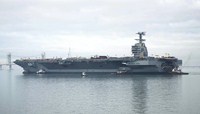Last month, Secretary of the Navy Ray Mabus told a crowd in Virginia that “we have the most advanced platforms in the world, but quantity has a quality of its own.” Mabus and other Navy leaders are currently grappling with severe budget constraints, and as he said those words the Navy was reportedly considering decommissioning one of its 10 active Nimitz-class aircraft carriers as a cost-saving measure. The $13 billion USS Gerald R. Ford, the first of the next-generation Ford-class carriers, was christened in November and is currently expected to join the fleet as the 11th carrier in 2016.*
Although the White House rejected this proposal, according to a report in the Wall Street Journal, cuts to the number of U.S. aircraft carriers remain a tempting option for cost-conscious analysts and policymakers. During a recent defense budget exercise in Washington, four teams from prominent defense think tanks all recommended cuts to the carrier force as a way to save money.
There is also a growing sense that new military technologies in the hands of U.S. rivals will make aircraft carriers more vulnerable and less usable near hostile shores. U.S. forces are facing the “proliferation of anti-ship cruise and ballistic missiles” as part of a broader spread of precision-guided weaponry to new actors, says Bill French of the National Security Network. “It’s questionable that the United States has sufficient countermeasures.”

